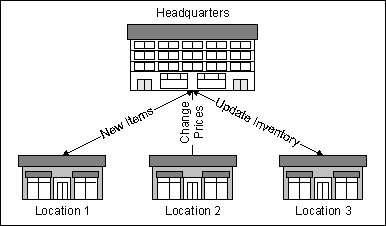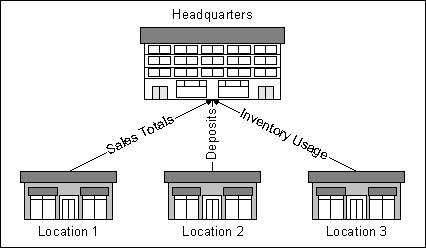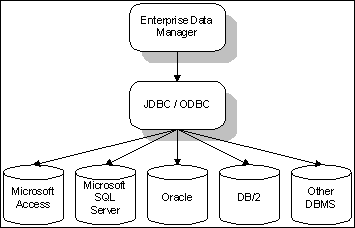

Any enterprise that operates multiple locations, such as restaurant chains, retail outlets, and service companies, has faced the problem of configuring, maintaining, and polling data for remote locations. New inventory items, changes in pricing, running specials, maintaining employee data, updating tax tables, collecting sales data, and many other examples present unique challenges for the multi-unit operator. Managing this information can be expensive and labor intensive.
Enterprises that operate multiple, remote locations have a number of common requirements for managing the data and applications that run in those locations.
When software applications are used in multiple remote locations, the configuration and maintenance of the data for those applications is an important part of efficient operations for the enterprise. Personnel at headquarters need to be able to add new items, change prices, delete obsolete data, and perform other operations on the remote databases.
Collecting data from multiple remote locations is also a very important part of managing the enterprise. Sales totals, inventory usage, and deposit information are required for corporate reporting, accounting and control.
Keeping track of what data is being changed and when it is being changed is essential for controlling data errors and security problems when data is spread out over multiple locations.
Some enterprises have developed their own internal terminology and need their application software to use that terminology to reduce training costs and increase efficiency. Enterprises with remote locations in multiple countries also need the ability to easily internationalize their applications. The ability to translate text, date formats, and currency formats is a key usability feature.
The wide variety of hardware and software platforms used to run applications in an enterprise’s remote locations means that their data management software must be flexible enough to run on many different computers and operating systems and support a wide variety of applications.
WebEDM enables users at a central location, like the company headquarters, to maintain selected portions of the databases for applications running at multiple remote locations and collect raw or summarized data from the locations. WebEDM maintains a central database with the data from the remote locations and provides powerful tools for managing and updating the data and synchronizing the data between the central database and the remote locations.
Users can configure and maintain data for multiple, remote locations from any central location including the company headquarters, a regional office, or a franchise headquarters. For example, the corporate headquarters for a restaurant chain may want to maintain the menu items and prices for all its restaurants while leaving maintenance of employees to the restaurant managers. Using WebEDM, users can add new items, change prices, update recipes and make any other necessary changes to the remote application databases. Changes made at the central location will be sent to the remote locations and applied to the database.
Changes to the database can be made at either the central location or a remote location. WebEDM will make sure that the central database and remote databases are always synchronized.

Configure and maintain remote system from central location.
With WebEDM, user can make a single change to the central database that updates hundreds or thousands of remote locations automatically. Special multi-location forms make it easy to view the data for multiple locations, see any differences in the data, and make changes. For example, users can select all the locations in the West region and use the Price form to change the price of item number 100 to $2.99 and every store in the West region will be sent a transaction to update their database.

A single change can affect multiple locations.
WebEDM includes powerful feature for automatically resolving a variety of possible data conflicts. Data conflicts occur when the data in the central location does not agree with the data in the remote location. For example, if a user at the store changes the price of item 100 to $3.49 and a user at headquarters changes the price of item 100 to $2.99, a conflict occurs. WebEDM enables users to decide whether the central data overrides the remote data or the remote data overrides the central data.
Users can configure the system to handle conflicts in any of the following ways:
With WebEDM, users can view the values of fields and records for any number of locations and see what differences there are among the locations if any. For example, if 100 locations sell a large coffee for $3.59 and 300 locations sell it for $3.99, users can not only see both prices but with a single keystroke, they can see which locations use which price.
Changes to the database can even include an effective date so that users can enter changes to be applied at some later date. For example, users at the central location might set the price of coffee to go up to 79 cents on January 1st and then go up to 89 cents on July 1st. These changes will be saved but not actually applied to the database until the effective date. Database changes can also include a termination date so that temporary changes can be made. For example, a company might run a special on an item by reducing its price to $1.99 from June 1st through June 15th. The WebEDM user simply enters the price change to $1.99 and specified a June 1st effective date and a June 15th termination date. The system will automatically change the price back to its original value on June 15th.
WebEDM is a very flexible system that can collect either raw or summarized data automatically from remote locations. Users can configure the system to bring new data for entire tables back to the central database or data can be summarized at the remote location and only the summary data brought back to the central database. It is a completely configurable and open system.

Collect sales data, deposits, time clock records as often as necessary.
Data collected in the central database from all the remote locations is instantly available for running the essential reports that provide the information to keep an enterprise competitive. Data collection can be scheduled as often as necessary to provide near-real-time reports even without a dedicated communication link to each remote location.
The central database can contain a great deal of information and sometimes the existing corporate reports don’t have exactly the information a user needs. With WebEDM, users can use the Query Designer to query the central database for the information they need using graphical tools instead of learning a query or programming language.
WebEDM enables users to share a single set of data among multiple locations dramatically reducing the data storage that would be required if every record from every location was stored individually. Users have complete control over which tables are shared and not shared and can set up as many share groups as necessary. For example, an enterprise might share a single set of item records among all its remote locations but have different sets of prices for each marketing area.
For enterprises that connect to remote locations via the internet, WebEDM can perform all communications using HTTP directly to the WebEDM server or by using the File Transfer Protocol (FTP). For enterprises that use a dial up network connection through Microsoft’s Remote Access Service (RAS), WebEDM can perform all necessary communications over the RAS connection. Communicating transactions between central and remote locations can be performed as a scheduled task nightly or at any other interval depending on the time sensitivity of the data.

XML transaction files are transmitted between locations.
WebEDM tracks all changes to central and remote databases so users know what data was changed and when it was changed. This capability is essential for maintaining security of the data, verifying when changes were successfully applied to remote databases, troubleshooting data problems, and discovering unauthorized or malicious changes to the data.
Users can configure WebEDM to manage just the portions of the remote application database that they need. For example, corporate users may want total control of items and prices but leave data management of the employee roster to the remote location managers.
Problems with data happen for a variety of reasons and WebEDM can help maintain the data integrity of all the remote application databases. When conflicts arise because of problems with the remote data, WebEDM can automatically refresh the problem table and all the related tables to get them back online quickly. The central database acts as a backup of key remote application data.
WebEDM users can verify and approve all changes to the database before they are delivered to the store. Transaction packages can be used to collect related changes over a period of hours, days, or weeks and the users can then commit the entire package to one or more selected remote locations. Users can also use WebEDM to load a test database in the lab at the central location to verify that all the changes were made properly before releasing the changes to the remote locations.
A graphical form designer is included in WebEDM that enables users to customize the screens they use to manage their application data. With the form designer, users can remove unneeded fields, change field descriptions or even add their own custom fields. Users can even create entirely new forms and tables to manage their data.
Many enterprises have developed their own internal terminology to describe the important information and events in their business. Using the WebEDM form designer, users can create or modify all the screens to use their business-specific terms without programming. This can reduce training time and increase efficiency.
With the WebEDM form designer, users can decide which fields are required and perform custom validation on field values even if the original application doesn’t! For example, the point-of-sale application may allow item numbers from 1 to 9 digits in length but corporate standards dictate that all item numbers must be from 1000 through 9999. The form designer enables users to validate item numbers according to the more restrictive corporate standard.
Enterprises with locations in multiple countries need to be able to translate the text, date formats, and currency formats on their screens. The WebEDM form designer, with full Unicode support, makes it easy to translate all the text, date formats, and currency formats in the system. The form designer even enables users to resize fields and change field locations when language translations cause the field sizes to change.
The server software is only installed once at headquarters and once at each location. Any number of users can access the software by simply opening their browser to a web page on the server. No software needs to be installed on each user’s computer, which reduces installation and maintenance costs. The server can be made visible through the firewall to allow users to access the system from anywhere via a secure Internet connection. If the server is visible on the Internet, service and support personnel can also access the system to provide assistance when needed.

Access applications and data from a web browser.
WebEDM supports JDBC/ODBC compliant databases starting with Microsoft SQL Server and Microsoft Access. Databases from other vendors can be supported with minimal effort as necessary. WebEDM can provide enterprise data management for any application whose database is accessible through JDBC or ODBC.

Supports any JDBC/ODBC accessible database with plugin.
Developed in the Java programming language, WebEDM can run on any operating system that supports the Java Runtime Environment including Windows, DOS, Unix, Linux, OS/2 and others.
WebEDM supports many different Point of Sale and Back Office packages as well as inventory, food cost, payroll, and other systems. WebEDM can be configured to work with applications from any vendor that use a supported database including custom applications, retail applications, and many others!
Interfacing with legacy systems and systems from other vendors is an important part of enterprise data management and WebEDM makes this task easy by providing direct query processing on compliant databases and full support for importing and exporting data.
For enterprises that need additional processing for data validation, data manipulation, or custom programs, WebEDM provides a programming interface that enables developers to add new features and functions to WebEDM. The possibilities are limitless!
WebEDM provides the power, flexibility, and security an enterprise demands for managing its strategic information resources! From configuring and maintaining remote applications, to summarizing and collecting the information essential to managing the enterprise, WebEDM is the solution!

RealTime Intelligence, LLC
11525 Carmel Commons Blvd, Suite 103
Charlotte, NC 28226
Phone: (704) 631-2500